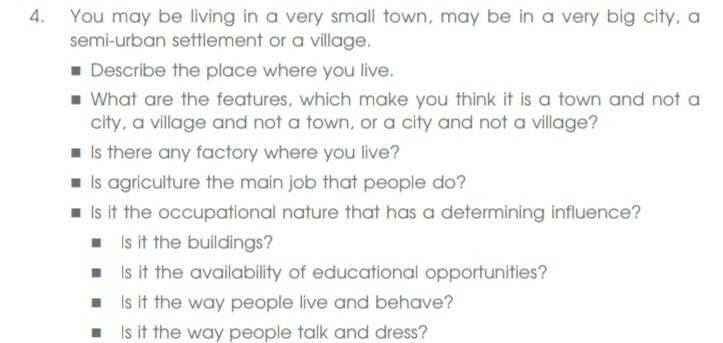
You may be living in a very small town, may be in a very big city, a semi urban settlement or a village.
- Describe the place where you live.
- What are the features^ which make you think it is a town and not a city, a village and not a town, or a city and not a village?
- Is there any factory where you live?
- Is agriculture the main job that people do?
- Is it the occupational nature that has a determining influence?
- Is it the buildings?
- Is it the availability of educational opportunities?
- Is it the way people live and behave?
- Is it the way people talk and dress?
-Anushree Ojha,Subject matter expert, Edumarz.
Solution :• I am based in Delhi. It is India’s national domain. For the most part, it is accepted that it is an old city of India, as shown in the epic Mahabharata. It was known as Indraprastha during the Mahabharata’s hour. It had been built and demolished by numerous people at various times. After the Mahabharata era’s leaders, Tomor Rajput established Delhi as their capital. It was also the capital during the Delhi Sultanate period and for the longest length of time during the Mughal period. Instead of Calcutta, the British chose it as their capital in 1911. It is currently India’s capital. It is a focal point of organization, strange turns of events, the headquarters of the World Health Organization, the center of exchange, and business as a learning center. Throughout the year, Delhi attracts visitors and travelers from many countries, niches, and corners of the globe. Its population is growing rapidly as a result of a number of factors including political, financial, social, strict, and other factors.•
The following highlights compelled me to believe that the plane on which I reside is a huge city and not a town or a town.
- It has been designated as an Indian metropolitan city. It has a population of almost 1.24 crores. It is, without a doubt, a massive metropolis.
- It is the Indian government’s headquarters. The President, Prime Minister, and all Central Government ministers, as well as over 700 sixty members of parliament and a few thousand authorities and representatives, live here. There are a few genuine landmarks, as well as shrines, mosques, houses of worship, and gurudwaras.
- Delhi is a key center for trade and commerce. Thousands of brokers and traders came to buy and sell these items. 7,000 people are working in various disciplines and divisions to provide services.
- There are 45 universities and 150 schools, preparatory facilities, and scholastic divisions in the country. There are a lot of railroad stations and crossroads, however there aren’t many significant airports. Palam Airport and Indira Gandhi International Airport are the two names for the airport.
- Each of the three national holidays, including Republic Day, Independence Day, and Gandhi Jayanti, is commemorated with a spectacular ceremony and display each year.
- All ambassadors and representatives from many countries come to live with or collaborate with the nation’s most notable and greatest pioneer and authority. Delhi is the headquarters of each of the three armed forces, such as the Army, Navy, and Air Force.
- Yes, there are numerous production lines and modern land in this city, where a few industrial facilities and businesses operate 24 hours a day, seven days a week. Linesmen and women work on the move in a few productions. It is a unique method of putting together activities or creating things.
- Agriculture is not the primary occupation of the people of Delhi. The administration section is an important part of the production process. Authorities, government representatives, educators, specialists, dealers, and other roles are filled by volunteers.
- Of course, the word “nature” has an impact on the creation of this metropolis, as well as the nation. Unique industrial, exchange, and business activities, as well as the administration sector, contribute to the zone’s national income and insensible high per capita income.
- In Delhi, there are colossal multi-story structures of varying sizes, both small and large. There are numerous clinics, nursing homes, schools, and colleges to name a few. The Delhi Development Authority’s multi-story structure, which serves as a railway/metro station, can be seen. There are magnificent and large five-star hotels as well as various motels.
- Delhi has an abundance of educational opportunities, with understudies being able to receive instructional services from class nursery to twelfth standard school. Significant understudies might find instructional opportunities at the undergraduate and graduate levels in a variety of institutions, colleges, and preparation centers. Universities of training, clinical science, designing skilled occupations, PCs, and so on are all in operation. There is great educational dispersion, which prepares understudies for a large number of IAS/IPS and other exams.
- The individuals live in peace and harmony with one another. They create a fantastic majority. A significant number of them are tenacious. They behave in a very sociable and appropriate manner. Individuals can be shared. They deal with a variety of challenges, such as a lack of water gracefully, power, and even a vehicle, intensely, heroically with a grin.
- People in Delhi speak in an incredibly fascinating manner. They create proper acquaintances with their known folks and explain the location of their work, parks, gardens, markets, and modes of transportation.
- The majority of Delhi residents adhere to a strict dress code. They dress in trendy as well as traditional attire. Individuals from a variety of Indian regions and Union domains can be seen dressed in their everyday and neighborhood garb. They speak in a variety of languages, including Hindi, English, Telugu, Punjabi, and other dialects.

